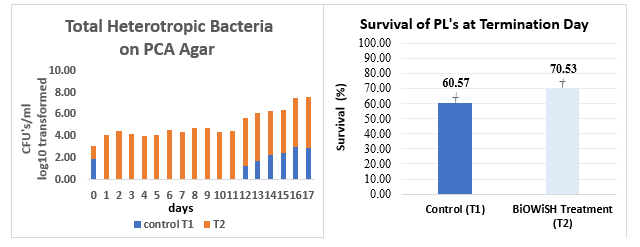EVALUATION OF POST LARVAL Litopenaeus vannamei HATCHERY PRODUCTION USING WATER QUALITY AND HEALTH STIMULATING PROBIOTICS
A hatchery trial was carried out at ShrimpVet hatchery in Ninh Thuan province, Vietnam whereby a probiotic protocol was compared to a non-probiotic protocol . In one treatment activated probiotics designed to improve water quality were applied daily, and the feed was coated with a probiotic designed to colonize on the shrimp gut. No probiotics were used in the other treatment.
The hatchery practiced strict biosecurity. Each treatment had three replicate 8 m3 tanks filled to 7 m3. Seawater used during the trial was filtered, settled, disinfected with chlorine, and disinfected by UV radiation before filling the tanks and used for water exchange. Water exchange in both treatments was 10 to 15 percent of tank volume daily. Water quality parameters analyzed on a daily basis included ammonia, nitrite, alkalinity, pH, dissolved oxygen, and temperature. Water samples were taken for bacterial analysis on PCA agar.
On harvest day post larvae from both treatments were analyzed for overall health based on FAO procedures which scores hepatopancreas lipid vacuoles , hepatopancreas color, hepatopancreas condition, intestinal content, muscle to gut ratio, and size variation. Post larvae from both treatments were sent to ShrimpVet laboratory in Ho Chi Minh City and subjected to a Vibrio parahaemolyticus AHPND (EMS) disease challenge.
Hatchery survival was improved by 17% when probiotics were applied. Post larvae health as defined by FAO assessment scoring was improved by 40% when probiotics were applied. Resistance to AHPND (EMS) challenge was improved by 8% when probiotics were applied. Probiotics increased shrimp hatchery sustainability and improved the quality and disease resistance of post larvae.
